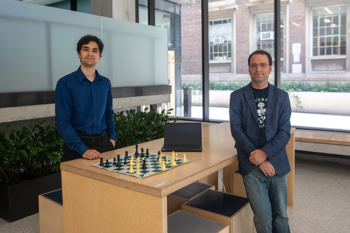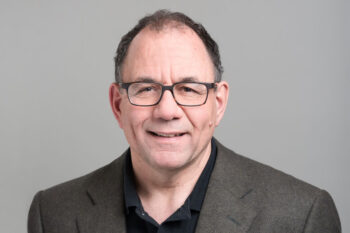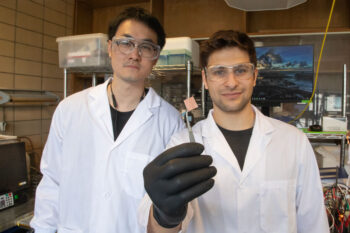How do you teach advanced manufacturing to an audience of 10-year-olds? Reach for the art supplies.
“Today, we’re using Play-Doh and melted crayons to illustrate the manufacturing process known as sand casting, which is used to make everything from pipe fittings to auto parts,” says Peter Serles (MIE PhD candidate). “The students will be making gears, which are a key concept in the elementary science curriculum.”
The colourful project was one of about a dozen hands-on learning activities developed for STEM Day, held for the first time at U of T Engineering on Nov. 6, 2019. The event brought together two groups: graduate students interested in pursuing a career as professors or instructors, and elementary school students who want to explore potential careers in science, technology, education or math (STEM).
Held in the Technology Enhanced Active Learning Rooms within U of T Engineering’s Myhal Centre for Engineering Innovation & Entrepreneurship, STEM Day attendees had the opportunity to learn about everything from facial recognition technology to environmental remediation.
STEM Day is part of the graduate course APS1203: Teaching Engineering in Higher Education, itself part of U of T Engineering’s Prospective Professors in Training program. As Professor Chirag Variawa (ISTEP) explains, STEM Day was designed to put some of the key concepts from the course into action.
“In this course, PhD students practice effectively communicating ideas from their research to undergraduate students,” says Variawa, the course instructor. “We thought, why stop there? Younger students tend to speak their minds — we’ll know right away if the translation has been successful.”
Variawa partnered with the Engineering Outreach office, which delivers interactive educational programs to thousands of pre-university students throughout the year. Together, they reached out to local elementary schools, inviting more than 60 students to campus to try out the learning activities designed by the prospective professors.
“We’ve been attending Go North Youth at U of T for the last couple of years,” says Rosemary Colangelo, a Grade 4/5 teacher at Secord Elementary School in Toronto. “Every time we get back, the kids can’t stop talking about all the cool things they got to tinker with. They start asking questions that they weren’t asking before.”
“We learned about the brain, we learned about energy, and so many other things,” says Robin Howard, a Grade 5 student in Colangelo’s class. “I thought engineering was strictly about buildings, but now I realize it’s not. There are a lot of ideas and creativity.”
Another key figure in organizing STEM Day is Michael Waldman, a STEM teacher with the Toronto District School Board (TDSB). In September, Waldman joined the Engineering Outreach team as the STEM Educator in Residence, working to further enhance collaborations between the University and local elementary teachers.
Waldman plans to host future events where elementary students can visit the Myhal Centre’s fabrication equipment facilities to learn first-hand how 3D printers and laser cutters work. “We also plan to reach out to engineering student mentors for a large-scale project,” he says.
“Those types of experiences can get students thinking about engineering in a different way, which is especially valuable for the type of kids who might not traditionally have considered an engineering education. It’s a really exciting partnership.”



